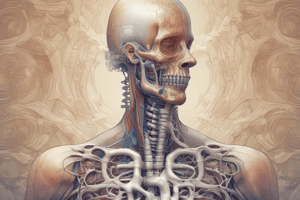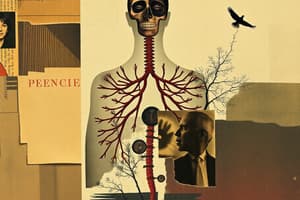Podcast
Questions and Answers
What role does the Dorsal Respiratory Group (DRG) play in the respiratory system?
What role does the Dorsal Respiratory Group (DRG) play in the respiratory system?
- It controls the basic rhythm of breathing.
- It inhibits the Ventrolateral Medulla.
- It integrates sensory information and modulates breathing rhythm. (correct)
- It promotes prolonged exhalation.
Which center is primarily responsible for promoting prolonged inhalation?
Which center is primarily responsible for promoting prolonged inhalation?
- Dorsal Respiratory Group
- Apneustic Center (correct)
- Central Chemoreceptors
- Pneumotaxic Center
How do central chemoreceptors primarily respond to changes in the body?
How do central chemoreceptors primarily respond to changes in the body?
- By monitoring blood pressure levels.
- By triggering inhalation based on sensory data.
- By sensing changes in cerebrospinal fluid pH. (correct)
- By detecting blood oxygen levels.
What is the function of the Pneumotaxic Center in the respiratory system?
What is the function of the Pneumotaxic Center in the respiratory system?
Which of the following is a function of the limbic system in relation to breathing?
Which of the following is a function of the limbic system in relation to breathing?
What is the primary role of baroreceptors in the respiratory system?
What is the primary role of baroreceptors in the respiratory system?
Flashcards are hidden until you start studying
Study Notes
Medullary Respiratory Centers
- Ventrolateral Medulla (VRG): Responsible for the basic rhythm and rhythmical patterns of breathing, acting as the primary generator of the breathing cycle.
- Dorsal Respiratory Group (DRG): Integrates sensory signals to modulate the breathing rhythm initiated by the VRG, ensuring a responsive breathing pattern.
Pneumotaxic Center
- Located in the pons, this center regulates the rate and pattern of breathing by inhibiting the VRG, promoting shorter and more rapid breaths.
Apneustic Center
- Also found in the pons, this center stimulates the VRG to promote prolonged inhalation, working alongside the pneumotaxic center to finely tune breathing patterns.
Chemoreceptors
- Central Chemoreceptors: Positioned in the medulla, they respond to pH changes in cerebrospinal fluid, providing an indirect measure of carbon dioxide (CO₂) levels.
- Peripheral Chemoreceptors: Located in the carotid bodies and aortic bodies, they detect variations in blood oxygen (O₂), CO₂, and pH levels.
Baroreceptors
- Found in the aortic arch and carotid sinuses, these receptors sense blood pressure changes and can modify breathing patterns accordingly.
Higher Brain Centers
- Cortex: Enables voluntary control over breathing, such as the ability to hold one's breath.
- Limbic System: Influences breathing patterns based on emotional states, such as anxiety or excitement.
Studying That Suits You
Use AI to generate personalized quizzes and flashcards to suit your learning preferences.




